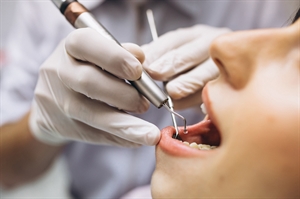All Categories
Featured
Table of Contents
In Twin Falls, ID, Alex Barajas and Isabel Cameron Learned About Things To Do In Frederick Md
What Is Preventive Dental Care? Dental care is very important to everyone. It is a way that you can maintain a healthy oral health and to keep your teeth from becoming decayed or infected. Here are some reasons why it is important to get regular dental checkups. When you are younger, your teeth can be very delicate so proper oral hygiene is essential. This means that you should brush and floss every day. It is also a good idea to visit your dentist at least once a year for checkups and cleanings. Your dentist will be able to take a look at your teeth and tell you what they think needs to be done. The first step in proper teeth cleaning and maintenance is a professional cleaning. It is important to note that cleaning is not always performed by a dentist. Some other factors that might require a professional cleaning include root canal treatments, fillings, crowns and dental implants. If a dentist performs the cleaning on an individual's own, it may be very difficult to maintain the quality of that individual's teeth and gums. The dentist will use an instrument known as a dental trying to clean the teeth and gums. Most dentists recommend a thorough cleaning procedure for any person who wants to practice proper dental hygiene. A dental traying is essentially an instrument that has four sections: The front, back, sides and crown. It can be used for cleaning the teeth and gums and removing plaque and bacteria. The teeth trays are then removed and the mouth is cleaned with antiseptic mouthwash. Periodontal disease is caused when bacteria grow in the pockets in between the teeth. An infection can travel to bone and cause serious and permanent damage to the bone. Periodontal diseases can be very painful and require root canal treatment. Another common type of problem is gum disease. Your dentist can diagnose this condition by taking a close look at your mouth. They will be able to tell you what needs to be done for your condition and if you need dental treatment or not. Dental care is not expensive. If you have problems, you should consult with a local dentist to determine what steps will need to be taken to correct the problem. When you visit the dentist, he or she will evaluate the problem and tell you what you can expect from a visit to the dental clinic. Dental hygienists perform the actual cleaning process when the patient enters the dentist's office and performs their oral care. They are trained in using the equipment and the dentist cleans the teeth and removes plaque and bacteria from the teeth. Some dentists offer dental health care as part of their overall practice. You can select a dentist that is able to offer the comprehensive treatment that is required for your specific problem. Before you make your decision, ask your dentist about your oral health history and any symptoms that you may have. Although most mouthwash products contain antibacterial or antiseptic ingredients, some people suffer from allergic reactions when using these products. Dentists usually suggest using a mouthwash that contains fluoride and sodium fluoride. The teeth are very delicate and require regular cleaning to prevent tooth decay. The dentist will usually clean the teeth between professional visits. Some common practices include using a root canal to treat cavity problems and maintaining the overall health of the teeth and gums. The dentist may also recommend braces to help strengthen the teeth. It can be very important to see your dentist for these types of oral problems. You do not want to wait to see a specialist. Most people have their problems fixed in the first visit, but they may need to see a specialist for more complicated conditions. Dental care is extremely important. You never know when you may need it. Your dentist can help you get the oral problems you need and prevent them from happening. Once you get better, you will be able to keep your teeth healthy and your smile beautiful for years to come.
City in Maryland, United StatesFrederick, MarylandCity of FrederickBridge on Carroll CreekMotto( s): "The City of Clustered Spires" Location within the State of MarylandShow map of MarylandFrederick (the United States) Show map of the United StatesCoordinates: Collaborates: United States Founded1745Government MayorMichael O'Connor (D-MD) Board of AldermenKelly Russell (D-MD) Ben MacShane (D-MD) Derek Shackleford (D-MD) Donna Kuzemchak (D-MD) Roger Wilson (D-MD) Area City24.
28 km2) Land23. 95 sq mi (62. 02 km2) Water0. 10 sq mi (0. 26 km2) Elevation302 feet (92 m) Population City65,239 Estimate 72,244 Density3,016. 95/sq mi (1,164. 84/km2) Urban141,576 (US: 230th)UTC5 (EST) Summertime (DST)UTC4 (EDT) 21701-21709301, 24024-30325GNIS feature ID0584497I-70, I-270, United States 15, United States 40, United States 340, MD 80, MD 144, MD 355Site Frederick is a city in, and the county seat, of Frederick County, Maryland.
Frederick has actually long been an important crossroads, situated at the crossway of a major northsouth Indian path and eastwest routes to the Chesapeake Bay, both at Baltimore and what ended up being Washington, D.C. and throughout the Appalachian mountains to the Ohio River watershed. It is a part of the Washington-Arlington-Alexandria, DC-VA-MD-WV Metropolitan Statistical Area, which is part of a higher Washington-Baltimore-Arlington, DC-MD-VA-WV-PA Combined Statistical Area.
Frederick is home to Frederick Municipal Airport (IATA: FDK), which accommodates general air travel, and to the county's biggest employer U.S. Army's Fort Detrick bioscience/communications research study installation. Found where Catoctin Mountain (the easternmost ridge of the Blue Ridge mountains) fulfills the rolling hills of the Piedmont region, the Frederick area ended up being a crossroads even before European explorers and traders showed up.
This ended up being referred to as the Monocacy Path or perhaps the Great Indian Warpath, with some tourists continuing southward through the "Great Appalachian Valley" (Shenandoah Valley, etc.) to the western Piedmont in North Carolina, or taking a trip down other watersheds in Virginia towards the Chesapeake Bay, such as those of the Rappahannock, James and York Rivers.

Established before 1730, when the Indian path ended up being a wagon road, Monocacy was abandoned before the American Revolutionary War, maybe due to the river's regular flooding or hostilities preceding the French and Indian War, or just Frederick's better area with much easier access to the Potomac River near its confluence with the Monocacy.
Three years earlier, All Saints Church had been established on a hill near a warehouse/trading post. Sources disagree as to which Frederick the town was named for, however the likeliest candidates are Frederick Calvert, sixth Baron Baltimore (among the proprietors of Maryland), Frederick Louis, Prince of Wales, and Frederick "The Great" of Prussia.
Frederick Town (now Frederick) was made the county seat of Frederick County. The county initially reached the Appalachian mountains (areas more west being contested in between the nests of Virginia and Pennsylvania up until 1789). The existing town's very first home was built by a young German Reformed schoolmaster from the Rhineland Palatinate named Johann Thomas Schley (died 1790), who led a party of immigrants (including his wife, Maria Von Winz) to the Maryland colony.
In Reno, NV, Thaddeus Jacobs and Leonel Mercer Learned About Frederick Events This Weekend
Schley's inhabitants likewise established a German Reformed Church (today known as Evangelical Reformed Church, and part of the UCC). Probably the oldest home still standing in Frederick today is Schifferstadt, integrated in 1756 by German settler Joseph Brunner and now the Schifferstadt Architectural Museum. Schley's group was amongst the many Pennsylvania Dutch (ethnic Germans) (along with Scots-Irish and French and later Irish) who migrated south and westward in the late-18th century.
Another important path continued along the Potomac River from near Frederick, to Hagerstown, where it split. One branch crossed the Potomac River near Martinsburg, West Virginia and continued down into the Shenandoah valley. The other continued west to Cumberland, Maryland and ultimately crossed the Appalachian Mountains into the watershed of the Ohio River.
Nevertheless, the British after the Proclamation of 1763 limited that westward migration route until after the American Revolutionary War. Other westward migrants continued south from Frederick to Roanoke along the Great Wagon Roadway, crossing the Appalachians into Kentucky and Tennessee at the Cumberland Gap near the Virginia/North Carolina border. Other German settlers in Frederick were Evangelical Lutherans, led by Rev.
They moved their objective church from Monocacy to what became a large complex a few blocks further down Church Street from the Anglicans and the German Reformed Church. Methodist missionary Robert Strawbridge accepted an invite to preach at Frederick town in 1770, and Francis Asbury arrived 2 years later, both assisting to found a congregation which ended up being Calvary Methodist Church, worshiping in a log structure from 1792 (although superseded by larger buildings in 1841, 1865, 1910 and 1930).
Jean DuBois was designated in 1792, which ended up being St. John the Evangelist Church (built in 1800). To manage this crossroads throughout the American Transformation, the British garrisoned a German Hessian regiment in the town; the war (the stone, L-shaped "Hessian Barracks" still stand). All Saints Church, put up 1813, Principal Parish Church until 1855As the county seat for Western Maryland, Frederick not just was an essential market town, however also the seat of justice.
Crucial legal representatives who practiced in Frederick consisted of John Hanson, Francis Scott Key and Roger B. Taney. Church Street with All Saints and Reformed Church spires, FrederickFrederick was also known throughout the 19th century for its spiritual pluralism, with among its primary roads, Church Street, hosting about a half dozen significant churches.


That original colonial structure was replaced in 1814 by a brick classical revival structure. It still stands today, although the principal praise space has become an even larger brick gothic church joining it at the back and facing Frederick's City Hall (so the parish remains the oldest Episcopal Church in western Maryland).
John the Evangelist, was developed in 1800, then rebuilt in 1837 (throughout the street) one block north of Church Street on East Second Street, where it still stands along with a school and convent developed by the Visitation Sis. The stone Evangelical Lutheran Church of 1752 was also rebuilt and enlarged in 1825, then changed by the current twin-spired structure in 1852.
In 15108, Jaiden Calderon and Jonathan Guerrero Learned About Frederick Things To Do
It ended up being an African-American churchgoers in 1864, renamed Asbury Methodist Episcopal Church in 1870, and constructed its existing building on All Saints Street in 1921. Together, these churches controlled the town, set against the backdrop of the first ridge of the Appalachians, Catoctin Mountain. The abolitionist poet John Greenleaf Whittier later celebrated this view of Frederick in his poem to Barbara Fritchie: "The clustered spires of Frederick stand/ Green-walled by the hills of Maryland." When U.S.
Louis (eventually developed to Vandalia, then the state capital of Illinois), the "National Pike" ran through Frederick along Patrick Street. (This later on became U.S. Path 40.) Frederick's Jacob Engelbrecht corresponded with Jefferson in 1824 (receiving a transcribed psalm in return), and kept a diary from 1819-1878 which stays a crucial first-hand account of 19th century life from its perspective on the National Roadway.
Church Street by a regional physician to prevent the city from extending Record Street south through his land to fulfill West Patrick Street. Frederick also ended up being one of the brand-new nation's leading mining counties in the early 19th century. It exported gold, copper, limestone, marble, iron and other minerals. As early as the American Revolution, Catoctin Heating system near Thurmont ended up being crucial for iron production.
Frederick had simple access to the Chesapeake and Ohio Canal, which started operations in 1831 and continued carrying freight till 1924. Also in 1831, the Baltimore and Ohio Railway (B&O) finished its Frederick Branch line from the Frederick (or Monocacy) Junction off the primary Western Line from Baltimore to Harpers Ferryboat, Cumberland, and the Ohio River.
Louis by the 1850s. Confederate troops marching south on North Market Street throughout the Civil War Frederick ended up being Maryland's capital city briefly in 1861, as the legislature moved from Annapolis to vote on the secession question. President Lincoln jailed several members, and the assembly was unable to convene a quorum to vote on secession.
Slaves likewise escaped from or through Frederick (given that Maryland was still a "servant state" although an unseceded border state) to join the Union forces, work versus the Confederacy and seek liberty. Throughout the Maryland campaigns, both Union and Confederate soldiers marched through the city. Frederick likewise hosted numerous health centers to nurse the injured from those fights, as relates in the National Museum of Civil War Medication on East Patrick Street.
Union Major General Jesse L. Reno's IX Corps followed Jackson's men through the city a couple of days in the future the method to the Fight of South Mountain, where Reno passed away. The websites of the fights are due west of the city along the National Roadway, west of Burkittsville. Confederate soldiers under Jackson and Walker unsuccessfully attempted to halt the Federal army's westward advance into the Cumberland Valley and towards Sharpsburg.
The 1889 memorial honoring Major General Reno and the Union soldiers of his IX Corps is on Reno Monolith Road west of Middletown, simply below the summit of Fox's Space, as is a 1993 memorial to killed Confederate Brig. Gen. Samuel Garland Jr., and the North Carolina troops who held the line.
In 8054, Tiana Cordova and Damari Freeman Learned About Fun Things To Do In Frederick
George McClellan after the Battle of South Mountain and the Battle of Antietam, delivered a brief speech at what was then the B. & O. Railway depot at the existing intersection of East All Saints and South Market Streets. A plaque honors the speech (at what is today the Frederick Neighborhood Action Company, a Social Services workplace).
The Army of the Potomac camped around the Possibility Hall residential or commercial property for the several days as skirmishers pursued Lee's Confederate Army of Northern Virginia prior to Gettysburg. A large granite rectangular monolith made from among the stones at the "Devil's Den" in Gettysburg to the east along the driveway honors the midnight change-of-command.
27 million in 2019 dollars) from residents for not taking down the city on their way to Washington D.C. Union troops under Major General Lew Wallace fought a successful delaying action, in what ended up being the last substantial Confederate advance at the Battle of Monocacy, also understood as the "Battle that saved Washington." The Monocacy National Battlefield lies just southeast of the city limitations, along the Monocacy River at the B.
Railroad junction where two bridges cross the stream - an iron-truss bridge for the railway and a covered wooden bridge for the Frederick-Urbana-Georgetown Pike, which was the site of the main battle of July 1864. Some skirmishing took place additional northeast of town at the stone-arched "Jug Bridge" where the National Roadway crossed the Monocacy; and an artillery barrage took place along the National Roadway west of town near Red Guy's Hill and Possibility Hall mansion as the Union troops pulled away eastward.
While Gettysburg National Battlefield of 1863 lies approximately 35 miles (56 km) to the north-northeast. The rebuilded home of Barbara Fritchie stands on West Patrick Street, just previous Carroll Creek linear park. Fritchie, a substantial figure in Maryland history in her own right, is buried in Frederick's Mount Olivet Cemetery.
Roosevelt when they stopped here in 1941 on a vehicle trip to the governmental retreat, then called "Shangra-La" (now "Camp David") within the Catoctin Mountains near Thurmont. Admiral Winfield Scott Schley (18391911) was born at "Richfields", the estate house of his father. He became an important naval commander of the American fleet on board his flagship and heavy cruiser USS Baltimore along with Admiral William T.
Major Henry Schley's son, Dr. Fairfax Schley, contributed in setting up the Frederick County Agricultural Society and the Great Frederick Fair. Gilmer Schley functioned as Mayor from 1919 to 1922, and the Schleys stayed among the town's leading families into the late-20th century. Nathaniel Wilson Schley, a prominent lender, and his other half Mary Margaret Schley helped arrange and raise funds for the yearly Great Frederick Fair, one of the 2 biggest agricultural fairs in the State.
Table of Contents
Latest Posts
Designing for Engagement: Enhancing User Interaction in Web Design
Designing for Attention: Capturing and Retaining User Focus in Web Design
From Concept to Code: The Web Design Process Demystified
More
Latest Posts
Designing for Engagement: Enhancing User Interaction in Web Design
Designing for Attention: Capturing and Retaining User Focus in Web Design
From Concept to Code: The Web Design Process Demystified